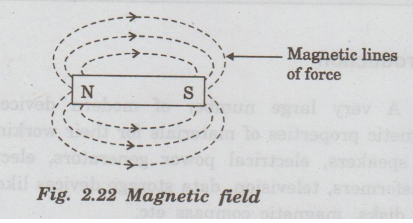Physics for Electrical Engineering: Unit II: b. Magnetic Properties of Materials
Magnetic Properties of Materials
A very large number of modern devices depend upon magnetic properties of materials for their working. For example, the speakers, electrical power generators, electrical machines, transformers, television, data storage devices like magnetic tapes and disks, magnetic compass etc.
UNIT II
(B)
Magnetic
Properties of Materials
Magnetic materials: Dia, para and ferromagnetic effects paramagnetism in the conduction electrons in metals exchange interaction and ferromagnetism quantum interference devices - GMR devices.
Introduction
A
very large number of modern devices depend upon magnetic properties of
materials for their working. For example, the speakers, electrical power
generators, electrical machines, transformers, television, data storage devices
like magnetic tapes and disks, magnetic compass etc.
MRI (Magnetic Resonance Imaging)
scan is an important non-invasive diagnostic tool used in the medical field.
Understanding
the origin of magnetism and the behaviour of magnetic materials will be helpful
not only in the selection of suitable materials for a particular application
but also in proper utilization of such devices.
Further, it is highly useful in designing new applications of these materials.
Magnetism in Materials
It
arises from the magnetic moment or magnetic dipole of the magnetic materials.
When an electron revolves around the positive nucleus, orbital magnetic moment
arises. Similarly when the electron spins, spin magnetic moment arises.
Materials which can be magnetised
by an external magnetic field are called magnetic materials.
The space around the magnet magi or
the current carrying conductor where the magnetic effect is felt is called
magnetic field.
Magnetic line of force is a
continuous curve in a magnetic field as shown in fig. 2.22. The
tangent at any point of this curve gives the direction of resultant intensity
at that point.

All
the molecules of a material contain electrons rotating around the nucleus.
These orbits are equivalent to circulating currents. So they produce a magnetic
motive force (m.m.f). m.m.f. is a force which produces the magnetic effect.
In most of the molecules, each m.m.f due to an
individual orbit is neutralised by an opposite one. But, in the magnetic
materials like iron and steel, there are number of unneutralised orbits. Then,
the resultant axis of m.m.f produces a magnetic
dipole.
In
unmagnetised specimens, the
molecular m.m.f axes lie along continuous closed paths. Therefore, no external
magnetic effect can be found.
In
magnetic specimens, the magnetic
dipoles will line up parallel with the exciting m.m.f.
When
the exciting m.m.f. is removed, the magnetic dipoles may remain aligned in the
direction of the external field. Thus,
it produces permanent magnetism.
Basic Definitions
To
understand the magnetic properties of materials in detail, we must study the
basic terms and definitions involved in magnetism.
Magnetic Pole Strength
Magnetic pole strength of a pole is
said to be unity it experiences a force of 1 Newton when placed at a distance
of 1 meter from a similar one, in air (or vacuum).
Magnetic Dipole Moment (m)
Magnetic dipole moment m of a
magnet is the product of magnetic pole strength and the distance between the
two poles.
Magnetic flux (ϕ)
Total
number of magnetic lines of force passing through a surface is known as
magnetic flux.
It
is represented by symbol (ϕ)and its unit
is weber (Wb).
Magnetic Flux Density (or) Magnetic Induction
(B)
Magnetic
field is applied to the metals such as iron, steel, some alloys etc, they are
magnetised to different degrees.
Magnetic
flux density at any point in a magnetic field is defined as the magnetic flux (ϕ)
passing normally through unit area of cross section (A) at that point.
It
is denoted by the symbol 'B' and its
unit is weber/metre2 (Wb/m2)
or tesla (T).
Magnetic
flux density is given by
B = ϕ / A weber/metre2 or
tesla (T).
It
is also called magnetic Induction
Intensity of Magnetisation (1)
The term magnetisation means the
process of magnetic material into a magnetic converting a non material.
When
an external magnetic field is applied to the metals such as iron, steel, some
alloys etc, they are magnetised to different degrees.
The intensity of magnetisation (I)
is the measure of magnetisation of magnetised specimen.
It is defined as the magnetic
moment per unit volume of the material.
i.e., I =M / Vweber / metre2
where
M→ Magnetic moment of the substance
V→
Volume of the specimen
Magnetic Field Intensity (or)
Strength (H)
Magnetic
field intensity at any point in a magnetic field is the force experienced by a
unit north pole placed at that point.
It
is denoted by 'H' and its unit is
newton per weber (N/Wb) or ampere
turns per metre (A/m).
Magnetic Permeability (μ)
Magnetic
permeability of a substance measures the degree to which the magnetic field can
penetrate through the substance.
It
is found that magnetic flux density (B) is directly proportional to the
magnetic field strength (H)
B
α N
Β
= μ Η
be
where
μ is a constant of proportionality.
It
is known as permeability or absolute permeability of the medium
μ
= B H
Thus,
the permeability of a substance is the ratio of magnetic flux density (B) inside the substance to magnetic
field intensity (H).
Absolute
permeability of a medium or a material is also defined as the product of
permeability of a free space (μ0)
and the relative permeability of the medium (μr)
i.e.,
μ= μ0 × μr
Unit
of permeability is henry/m (or) H/m
Relative Permeability (μr)
of a Medium
Relative
permeability of a medium is defined as the ratio between absolute permeability
of a medium (μ) to permeability of a
free space (μ0)
μr=
μ / μ0
Thus,
the relative permeability is purely a number and it has no unit. For air and
non- magnetic material, its value is '1'.
Magnetic Susceptibility (χ)
Magnetic susceptibility (χ) of a specimen is a measure of how easily
a specimen can be magnetised in a magnetic field.
It is defined as the intensity of
magnetisation produced in the substance per unit magnetic field strength (H).
χ = I / H
It
is a dimensionless quantity because both I and H have same units.
Magnetic
induction in a given magnetic material for the applied field strength 'H' is
given by
B
= μ0 (H+I)
B
= μ0H [1+ I/H]
B/H
= μ0(1+ χ)...(1)
(I/H
= χ)
But,
we know that
B/
H = μ = μ0 μr...(2)
(μ=μ0μr..)
From
the eqns (1) and (2), we have
MAIQ
ars
μ0
μr = μ0 (1 + χ)
μr
= 1+ χ
χ
= μr-1
Physics for Electrical Engineering: Unit II: b. Magnetic Properties of Materials : Tag: : - Magnetic Properties of Materials
Related Topics
Related Subjects
Physics for Electrical Engineering
PH3202 2nd Semester 2021 Regulation | 2nd Semester EEE Dept 2021 Regulation
